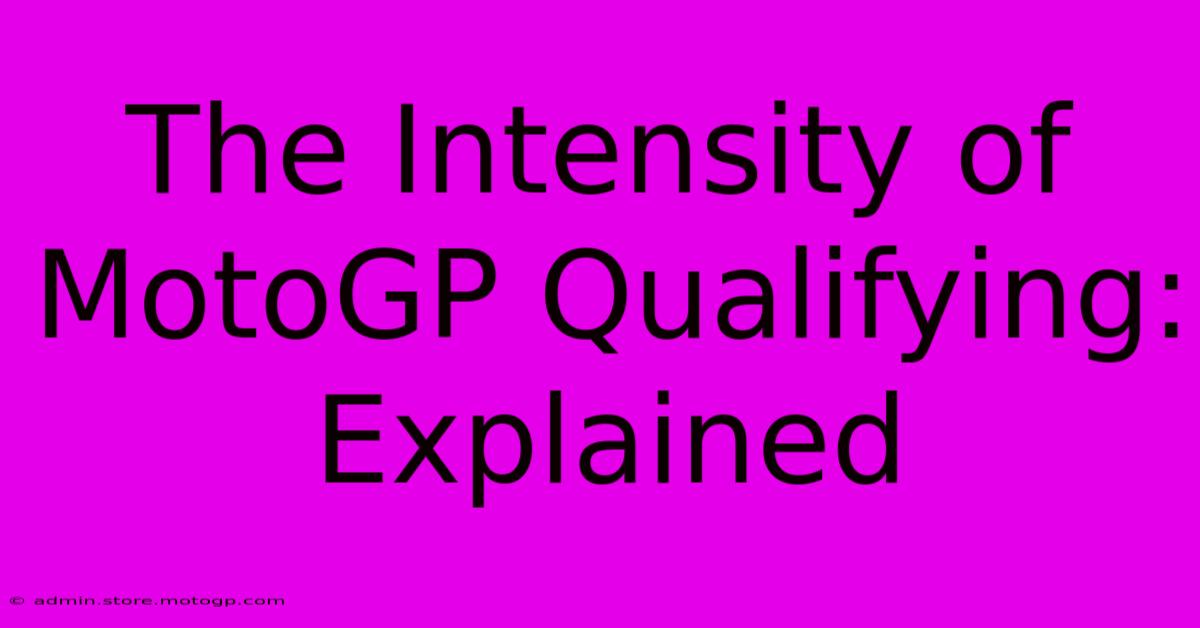The Intensity Of MotoGP Qualifying: Explained

Table of Contents
The Intensity of MotoGP Qualifying: Explained
MotoGP qualifying. The very words conjure images of screaming engines, razor-sharp cornering, and the sheer, breathtaking speed of the world's fastest motorcycles. But what actually happens during those crucial minutes that decide grid positions for the race? It's more than just a fast lap; it's a complex, high-stakes dance of skill, strategy, and a little bit of luck. This article dives deep into the intensity of MotoGP qualifying, breaking down the process and explaining why it's so crucial to the outcome of the race.
Understanding the Qualifying Format
The current MotoGP qualifying format is designed to maximize drama and ensure the fastest riders are at the front of the grid. It's a multi-stage process:
Q1: The Fight for Survival
The session begins with Q1, where the slowest ten riders from the combined Free Practice sessions (FP1, FP2, and FP3) battle it out. Only the top two riders from Q1 progress to Q2, while the remaining eight start the race from positions 13-20. The pressure is immense; a single mistake can mean the difference between a front-row start and a battle from the back. This is where we often see incredible overtakes and last-minute heroics.
Q2: The Championship Showdown
Q2 is where the top 10 riders from the combined Free Practice sessions, along with the two qualifiers from Q1, compete for pole position. This is the pinnacle of qualifying, a high-octane display of skill and precision. Every tenth of a second counts, and the slightest error can cost a rider a valuable position on the grid. The battle for pole is legendary, with riders pushing their machines and themselves to the absolute limit.
The Factors Contributing to the Intensity
Several factors contribute to the intense atmosphere of MotoGP qualifying:
The Pressure is On:
The pressure on the riders is immense. A good starting position significantly improves their chances of winning the race, while a poor position can make victory extremely difficult. The stakes are high, both for the riders and their teams.
Tire Management:
Riders need to manage their tires carefully during qualifying. Pushing too hard early can lead to tire degradation, making it difficult to set a fast lap at the end of the session. The strategic use of tires is a key component of successful qualifying.
Track Conditions:
Track conditions play a crucial role in qualifying. Temperature, humidity, and even the amount of rubber laid down on the track can affect grip and lap times. Adapting to changing conditions is essential for success.
Slipstream and Teamwork:
Slipstreaming, or drafting, is a crucial tactic in qualifying. Riders attempt to follow closely behind each other to benefit from the reduced aerodynamic drag. Teams often work together strategically, with one rider acting as a "tow" for their teammate. This aspect introduces a level of team strategy and collaboration rarely seen in other motorsports.
The Significance of Qualifying
The impact of qualifying extends far beyond just the starting grid. A strong qualifying performance:
- Boosts rider morale: Starting at the front provides confidence and momentum.
- Gives a competitive advantage: A good grid position increases the chance of avoiding early-race incidents.
- Impacts race strategy: The starting position influences race strategy, allowing riders to plan their overtaking maneuvers.
In conclusion, MotoGP qualifying is far more than just a series of fast laps. It’s a critical stage of the Grand Prix weekend, a microcosm of the entire race, showcasing the riders' skills, their teams' strategies, and the unpredictable nature of motorsport itself. The intensity is palpable, the competition fierce, and the outcome hugely influential on the race's final result. The fight for pole position is a spectacle in itself, a thrilling prelude to the main event.

Thank you for visiting our website wich cover about The Intensity Of MotoGP Qualifying: Explained. We hope the information provided has been useful to you. Feel free to contact us if you have any questions or need further assistance. See you next time and dont miss to bookmark.
Featured Posts
-
F1 Vs Moto Gp Experience The Thrill
Feb 19, 2025
-
Escape The Ordinary Cota Open Track Days
Feb 19, 2025
-
Lot R Cota Results Guaranteed
Feb 19, 2025
-
Limited Edition Racing Motorcycles Grab Yours Now
Feb 19, 2025
-
Cota Parking Lot T Insider Tips And Tricks
Feb 19, 2025
